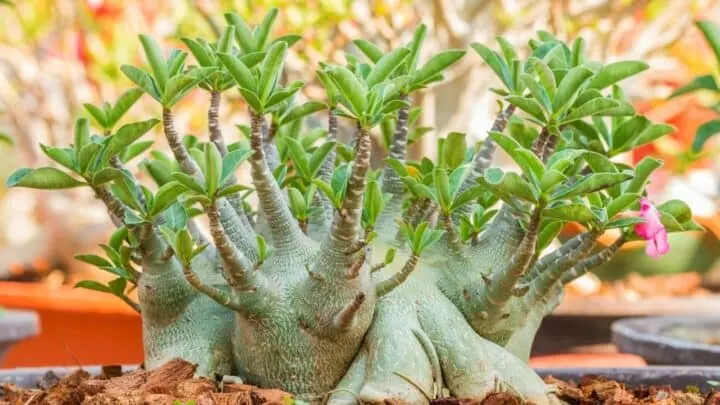You are searching for Desert Rose bonsai care tips and I can assure you this article is what you are looking for.
The Desert Rose bonsai or Adenium bonsai is a popular and very beautiful bonsai. It is loved for its profusion of large pink flowers and its strange, sturdy, bulbous trunk.
Desert Rose (Adenium obesum) is a succulent shrub native to the desert regions south of the Sahara and tropical and subtropical regions of eastern and southern Africa and Arabia according to the University of Arizona.
Desert Rose Takeaways
| Species | Adenium obesum |
| Synonyms | Desert Rose, Mock Azalea, Sabi Star, Kudu, Impala Lily |
| Family | Apocynaceae |
| Genus | Adenium |
| Growth | Compact, bushy |
| Height | 3.0 feet (if not a bonsai) |
| Width | 2.0 feet (if not a bonsai) |
| Soil | Well-draining |
| Watering | Water every 7-10 days |
| Light | Full sun |
| Temperature | 70.0 - 90.0 °F (21.11 - 32.22 °C) |
| Humidity | 40.0 - 60.0 % |
| Fertilizer | Every 2 months |
| Propagation | Stem cuttings or seeds |
| Toxicity | Toxic |
Desert Rose – Adenium Obesum
Adenium Obesum is drought-deciduous evergreen but it can lose its leaves during sudden cold spells. It has fleshy, succulent leaves and a bulbous trunk. Its flowers are large, pink or red.
The Desert Rose is often seen in the gardens in tropical countries, but it is a popular ornamental plant all over the world. It is often grown in pots to be put inside when the temperature drops.
It adjusts very well to growing in pots, which makes it fairly easy to train as bonsai.
With care and love, you can grow beautiful desert rose bonsai that will provide you with a profusion of flowers every year.
Keep in mind that the milk sap of the Desert Rose is poisonous, so wear gloves when pruning or wiring.
Desert Rose Bonsai Care
To care for a Desert Rose Bonsai provide bright direct light and water once the soil is completely dry. As potting soil use bonsai soil consisting of clay and sand and some potting mix. Grow in a temperature between 70-100° F (20-38°C). Fertilize every 3-4 weeks in spring and summer with a diluted fertilizer to 1/3 of the recommended strength. Humidity around 40% is just right.
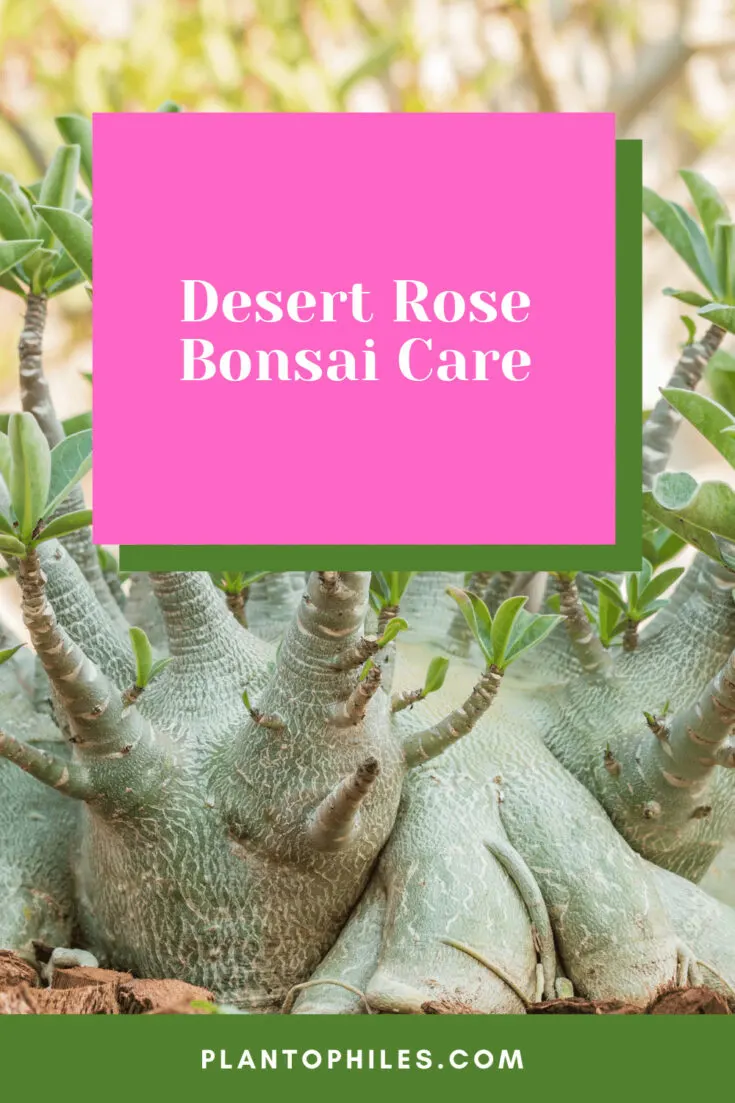
Table of Contents
Desert Rose Bonsai Care Guide
In North America and other parts of the world where the temperature drops below 40 degrees Fahrenheit (5° C), your desert rose bonsai will bloom profusely during the warmer months but will go dormant when it gets colder.
At that point, bring your bonsai indoors. Most of them drop their leaves during this dormant period, but some do not. If your desert rose bonsai loses its leaves, you can enjoy its strange large trunk and small branches.
The desert rose blooms are large, pink with a dark pink edge, and very long-lasting.
They are beloved by hummingbirds, bees, and butterflies. As you train and trim your bonsai, the new leaves will grow smaller, but the flowers will remain very large.
Soil
For a Desert Rose Bonsai use bonsai soil consisting of clay and sand mixed with organic matter.
As a desert dweller in its native home, the Desert Rose Bonsai does not need much water.
The roots can never be allowed to sit in water, so well-draining soil is the key to your desert rose bonsai good health.
Use special bonsai soil that is made of course particles of clay and sand, mixed with organic matter. Such mix cannot be overwatered, it drains very well and the organic matter retains enough nutrients to feed your plant.
If you cannot get bonsai soil, you can use a cactus soil mix.
Watering
Water Desert Rose bonsai in summer when the soil is completely dry to the touch.
During the hot summer months when your desert rose bonsai is growing actively, check the soil every few days. If the soil is completely dry, water it slowly and generously, until water comes out of the hole in the pot. The Desert Rose bonsai dislikes soggy soil.
That said, let the soil dry out between watering. Cut back on watering once your desert rose bonsai enters a dormant period.
Light
Desert Rose bonsai loves plenty of sun and bright light. You can leave it outdoors in full sun during the active growing period.
If you do not have outdoor space for your bonsai, make sure that it gets the same amount of light as it would outdoors.
Ideally, it should be placed on a balcony, deck, or at least on the window sill to get as much sun as possible. When you bring your bonsai indoors, when the temperature drops, put it in a warm, bright spot.
If you keep your desert rose bonsai in the warm, bright greenhouse, it will keep growing year-round.
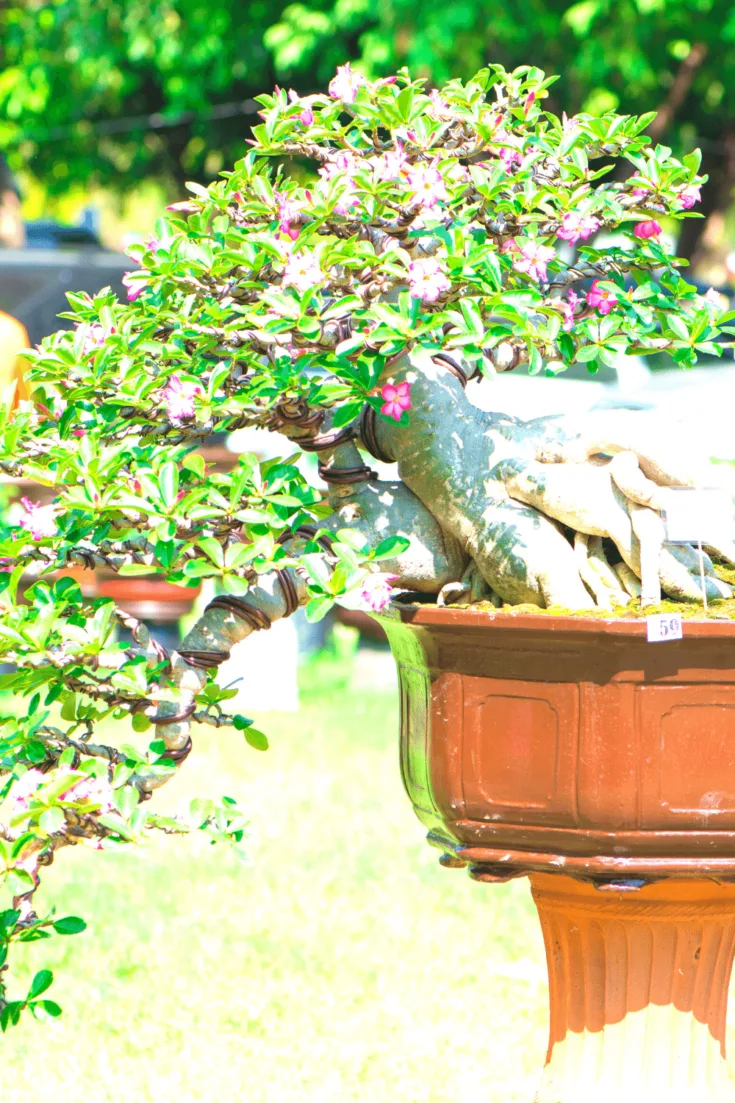
Temperature
Desert Rose bonsai thrives in a climate where the temperature never drops below 70°F (20°C). It is fine even when the temperature reaches 100° F (38°C).
The temperature should not be allowed to fall below 40° F (5° C).
If your bonsai is kept outdoors, bring it inside when it looks like the temperature is going to drop below 40° F (5° C).
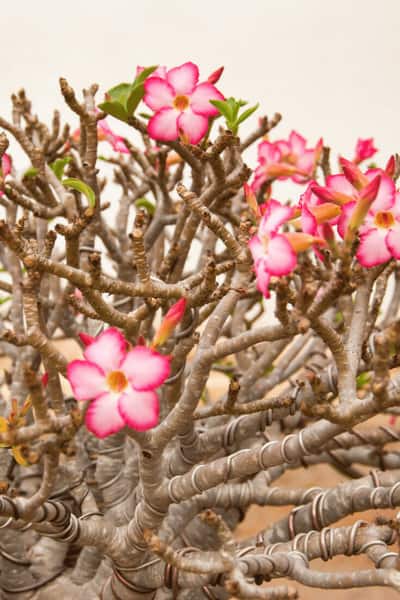
Fertilizer
While a Desert Rose bonsai is actively growing in spring and summer, it should be fertilized every 3-4 weeks with a balanced fertilizer diluted to 1/3 of its strength. A good NPK value is eg. NPK 1:1:1.
Also, give it an occasional feed in spring, when your plant is waking up from its dormancy. During summer, it is enough to feed your bonsai once a month. Stop feeding your desert rose bonsai completely once the weather cools and let it go dormant.
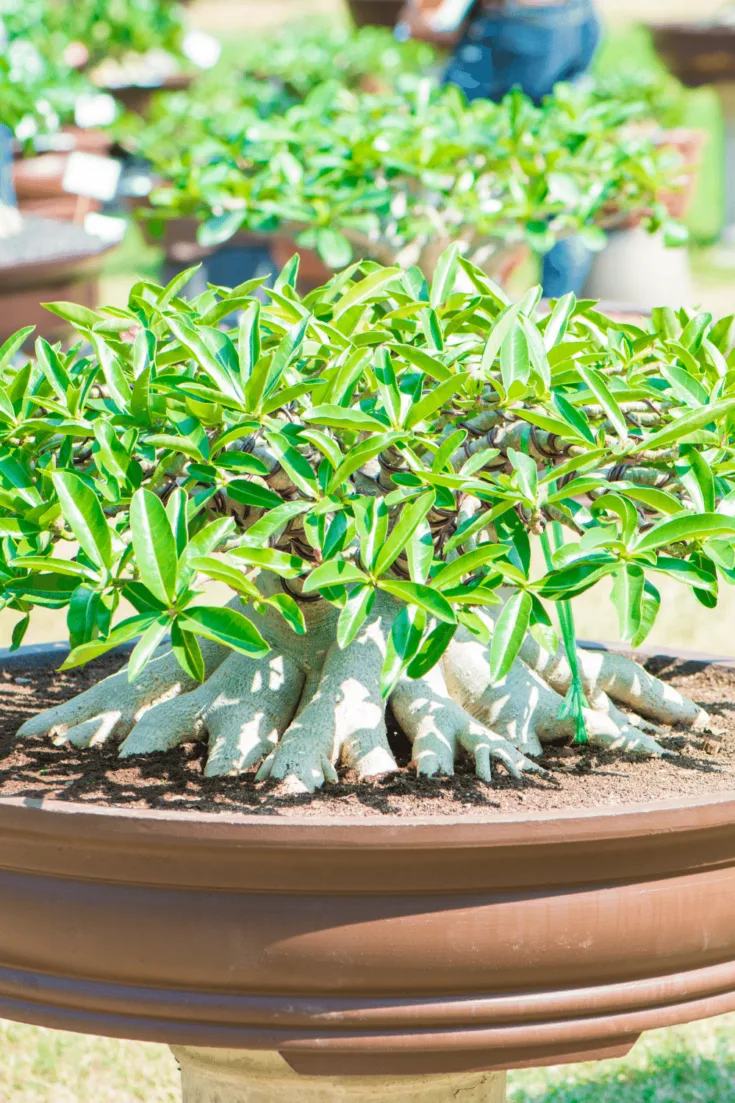
Humidity
The ideal humidity level is around 40% for Desert Rose bonsai as the name suggests we are dealing with a desert species.
Pots
Desert Rose bonsai are grown in special shallow pots, with a large drainage hole and small holes around the pot for tying the tree. Because of its bulbous trunk, desert rose bonsai looks particularly interesting in shallow pots or trays.
The pot should not be bigger than two-thirds of the height of the tree. Its color should complement the color of the tree or the color of flowers.
Your bonsai probably was already planted in the appropriate pot when you purchased it. Bonsai pots are very important for the overall look of your bonsai.
Repotting
Desert Rose bonsai should be repotted every two to three years since a mature desert rose grows fairly slowly. You can re-pot it more often if you see that the roots completely filled the pot.
The repotting is fairly easy and should be done in early spring. First, untie your tree from its pot. Heavy trees often come tied to the pot so that the fine roots do not get broken from the movements of the tree.
Shake off the old soil and comb the roots with a chopstick. Trim all thick old roots and leave small feeder roots. Trim roots evenly all around the root ball to keep it balanced.
Do not cut off more than two-thirds of the root ball. Wash the roots and the pot. Put a layer of fresh soil mix at the bottom of the pot and place the tree on top. Fill the rest of the pot with the fresh soil mix.
Use the same pot or the same size pot. A larger pot would encourage the growth of more roots and your goal is to keep the tree small.
Wiring
When you wire the branches of your Desert Rose bonsai, do not wire them too tightly or the wire will cut into the growing branches and leave ugly wire marks.
Wiring is not necessary if your branches are growing in the direction you desire. Bonsai trees are wired to give you the opportunity to place them in the desired form while they are growing.
Use soft aluminum or copper wire. Once wired, gently position the wired branch in the direction you want it to grow.
Pruning
Pruning or trimming your Desert Rose bonsai is necessary to keep it small and growing in the form you desire. You can prune the desert rose bonsai year-round.
Pruning encourages more ramification of the branches. As a result, your plant develops more flower buds since the buds develop on new growth. Trim back all long shoots.
Cut off damaged parts and branches that grow in the wrong direction. When you cut, make clean cuts just above a leaf node. Wear gloves when trimming your desert rose, the sap is poisonous.
Blooms
If you provide your Desert Rose bonsai with ideal conditions, it will give you two seasons of blooming. First, the flowers will begin to form in early spring and should bloom until mid-summer.
Then, in the heart of the hottest summer, the plant will take 6-8 weeks break and continue to bloom in the early autumn months.
If you keep your desert rose bonsai in a warm, brightly lit greenhouse, it might remain active year-round.
Common Pests & Problems
The biggest problem your Desert Rose bonsai might suffer from is root rot. It can be easily avoided by using only free-draining, coarse bonsai soil. This plant should never be sitting in water. It dislikes soggy soil.
Pests that frequently affect desert roses are aphids, spider mites (tetranychus urticae), mealybugs, and scales.
Treat your desert rose with neem oil insecticide as soon as you spot any signs of infestation.
If you see Oleander caterpillars, pick them by hand and spray your bonsai with Bacillus thuringiensis.
Propagation
You can propagate Desert Rose bonsai from cuttings or seeds, but all you will get is the tiny desert rose plants. You will be a very long way from the young plant to the bonsai.
Bonsai takes a long time to grow and care for so it looks like a mature tree in a pot. If you want a new desert rose bonsai, get another one from a reputable bonsai grower.
Tools
It is easy to fall in love with your Desert Rose bonsai and to start considering it a family member. You might want to invest in a few basic tools for its care.
Start with good quality bonsai cutters, for trimming branches and roots. You will also need small pliers for wiring your bonsai branches, and some soft aluminum or copper wire.
Always use gloves when working with your desert rose to avoid its poisonous sap.
Conclusion About Desert Rose bonsai care
A Desert Rose Bonsai is a delightful little tree that will give you years of pleasure with just a bit of care. If you give it plenty of sun, warmth, and protection from cold, it will reward you with a profusion of large pink blooms twice a year.

Daniel has been a plant enthusiast for over 20 years. He owns hundreds of houseplants and prepares for the chili growing seasons yearly with great anticipation. His favorite plants are plant species in the Araceae family, such as Monstera, Philodendron, and Anthurium. He also loves gardening and is growing hot peppers, tomatoes, and many more vegetables.

